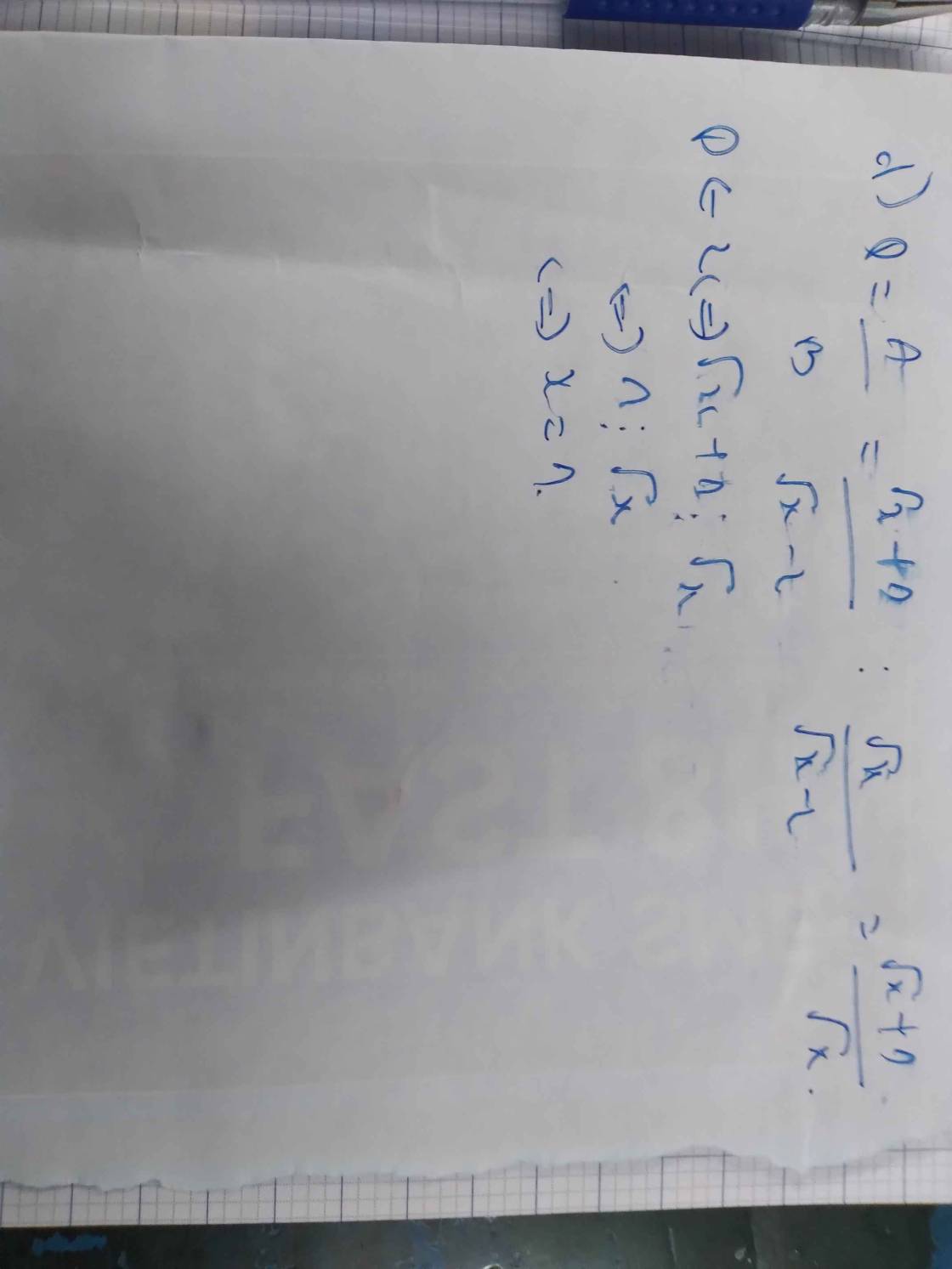Tìm x thuộc Z để biểu thức có giá trị nguyên: A=\(\dfrac{2\sqrt{x}+3}{3\sqrt{x}-1}\)
H24
Những câu hỏi liên quan
Cho biểu thức A = \(\dfrac{2}{\sqrt{x}-3}\) + \(\dfrac{2\sqrt{x}}{x-4\sqrt{x}+3}\) + \(\dfrac{\sqrt{x}}{\sqrt{x}-1}\)
a, Rút gọn biểu thức A
b, Tìm x thuộc Z để biểu thức A nhận giá trị nguyên
\(a,A=\dfrac{2\sqrt{x}-2+2\sqrt{x}+x-3\sqrt{x}}{\left(\sqrt{x}-3\right)\left(\sqrt{x}-1\right)}\left(x\ge0;x\ne1;x\ne9\right)\\ A=\dfrac{x+\sqrt{x}-2}{\left(\sqrt{x}-3\right)\left(\sqrt{x}-1\right)}=\dfrac{\left(\sqrt{x}+2\right)\left(\sqrt{x}-1\right)}{\left(\sqrt{x}-3\right)\left(\sqrt{x}-1\right)}=\dfrac{\sqrt{x}+2}{\sqrt{x}-3}\)
\(b,A\in Z\Leftrightarrow\dfrac{\sqrt{x}-3+5}{\sqrt{x}-3}\in Z\Leftrightarrow1+\dfrac{5}{\sqrt{x}-3}\in Z\\ \Leftrightarrow\sqrt{x}-3\inƯ\left(5\right)=\left\{-5;-1;1;5\right\}\\ Mà.x\ge0\\ \Leftrightarrow\sqrt{x}\in\left\{2;4;8\right\}\\ \Leftrightarrow x\in\left\{4;16;64\right\}\)
Đúng 0
Bình luận (0)
a) ĐKXĐ: \(\left\{{}\begin{matrix}x\ge0\\x\ne9\\x\ne1\end{matrix}\right.\)
\(A=\dfrac{2\sqrt{x}-2+2\sqrt{x}+x-3\sqrt{x}}{\left(\sqrt{x}-3\right)\left(\sqrt{x}-1\right)}=\dfrac{x+\sqrt{x}-2}{\left(\sqrt{x}-3\right)\left(\sqrt{x}-1\right)}=\dfrac{\left(\sqrt{x}-1\right)\left(\sqrt{x}+2\right)}{\left(\sqrt{x}-1\right)\left(\sqrt{x}-3\right)}=\dfrac{\sqrt{x}+2}{\sqrt{x}-3}\)
b) \(A=\dfrac{\sqrt{x}+2}{\sqrt{x}-3}=1+\dfrac{5}{\sqrt{x}-3}\in Z\)
\(\Rightarrow\sqrt{x}-3\inƯ\left(5\right)=\left\{-5;-1;1;5\right\}\)
Kết hợp đk
\(\Rightarrow x\in\left\{4;16;64\right\}\)
Đúng 1
Bình luận (0)
Tìm giá trị của x thuộc Z để biểu thức sau có giá trị nguyên
\(\dfrac{3}{\sqrt{x}+2}\) với x > 0
Để biểu thức nguyên thì \(3⋮\sqrt{x}+2\)
\(\Leftrightarrow\sqrt{x}+2=3\)
\(\Leftrightarrow\sqrt{x}=1\)
hay x=1
Đúng 0
Bình luận (0)
Tìm giá trị của x thuộc Z để biểu thức sau có giá trị nguyên
\(\dfrac{3}{\sqrt{x}+2}\) với x > 0
\(\dfrac{3}{\sqrt{x}+2}\in Z< =>\sqrt{x}+2\inƯ\left(3\right)=\left\{\pm1;\pm3\right\}\)
mà \(x>0=>\sqrt{x}+2>2\) nên \(\sqrt{x}+2=\left\{3\right\}=>x=1\left(tm\right)\)
Vaayy.....
Đúng 1
Bình luận (0)
Để biểu thức \(\dfrac{3}{\sqrt{x}+2}\) nguyên thì \(3⋮\sqrt{x}+2\)
\(\Leftrightarrow\sqrt{x}+2=3\)
\(\Leftrightarrow\sqrt{x}=1\)
hay x=1
Đúng 0
Bình luận (0)
Tìm giá trị nguyên của x để biểu thức \(P=\dfrac{B}{A}\) có giá trị nguyên biết A =\(\dfrac{\sqrt{x}+2}{\sqrt{x}-3}\) và B =\(\dfrac{\sqrt{x}+2}{\sqrt{x}-1}\)
\(P=\dfrac{B}{A}\\ =\dfrac{\sqrt{x}+2}{\sqrt{x}-1}:\dfrac{\sqrt{x}+2}{\sqrt{x}-3}\\ =\dfrac{\sqrt{x}+2}{\sqrt{x}-1}\cdot\dfrac{\sqrt{x}-3}{\sqrt{x}+2}\\ =\dfrac{\sqrt{x}-3}{\sqrt{x}-1}\\ =\dfrac{\sqrt{x}-1-2}{\sqrt{x}-1}\\ =1-\dfrac{2}{\sqrt{x}-1}\)
Để \(P=\dfrac{B}{A}\) có giá trị nguyên
Thì \(2⋮\left(\sqrt{x}-1\right)\Rightarrow\left(\sqrt{x}-1\right)\inƯ\left(2\right)=\left\{2;-2;1;-1\right\}\)
| \(\sqrt{x}-1\) | 2 | -2 | 1 | -1 |
| \(x\) | 9 | ∅ | 4 | 0 |
| Nhận - Loại | nhận | loại | nhận | nhận |
Vậy \(x\in\left\{9;4;0\right\}\) thì \(x\) nguyên và \(P\) có giá trị nguyên
Đúng 3
Bình luận (0)
Tìm các giá trị nguyên của x để các biểu thức sau có giá trị nguyên
A=\(\dfrac{x+2}{x-5}\) B=\(\dfrac{3x+1}{2-x}\) C=\(\dfrac{\sqrt{x}+3}{\sqrt{x}-2}\) D=\(\dfrac{2\sqrt{x}-1}{\sqrt{x}+3}\)
\(A=\) \(\dfrac{x+2}{x-5}\)
\(=\dfrac{\left(x-5\right)+7}{x-5}\)
\(=1+\dfrac{7}{x-5}\)
để \(\dfrac{7}{x-5}\) ∈Z thì 7⋮x-5
⇒x-5∈\(\left(^+_-1,^+_-7\right)\)
Còn lại thì bạn tự tính nha
Đúng 1
Bình luận (0)
Tìm x thuộc Z để biểu thức nhân giá trị nguyên: \(\dfrac{5\sqrt{x}-6}{2\sqrt{x}-3}\)
Giải chi tiết được ko ạ?
Để biểu thức đề bài cho có giá trị nguyên thì \(5\sqrt{x}-6⋮2\sqrt{x}-3\)
\(\Leftrightarrow10\sqrt{x}-12⋮2\sqrt{x}-3\)
\(\Leftrightarrow2\sqrt{x}-3\in\left\{-3;-1;1;3\right\}\)
\(\Leftrightarrow2\sqrt{x}\in\left\{0;2;4;6\right\}\)
hay \(x\in\left\{0;1;4;9\right\}\)
Đúng 1
Bình luận (0)
6.A=\(\left(\dfrac{2}{\sqrt{x}-3}+\dfrac{2\sqrt{x}}{x-4\sqrt{x}+3}\right):\dfrac{2\left(x-2\sqrt{x}+1\right)}{\sqrt{x}-1}\)
a) Rút gọn A
b)Tìm a ϵ Z để biểu thức A nhận giá trị nguyên
a) Ta có: \(A=\left(\dfrac{2}{\sqrt{x}-3}+\dfrac{2\sqrt{x}}{x-4\sqrt{x}+3}\right):\dfrac{2\left(x-2\sqrt{x}+1\right)}{\sqrt{x}-1}\)
\(=\dfrac{2\left(\sqrt{x}-1\right)+2\sqrt{x}}{\left(\sqrt{x}-3\right)\left(\sqrt{x}-1\right)}:\dfrac{2\left(\sqrt{x}-1\right)^2}{\left(\sqrt{x}-1\right)}\)
\(=\dfrac{4\sqrt{x}-2}{\left(\sqrt{x}-3\right)\left(\sqrt{x}-1\right)}\cdot\dfrac{1}{2\left(\sqrt{x}-1\right)}\)
\(=\dfrac{2\sqrt{x}-1}{\left(\sqrt{x}-3\right)\left(\sqrt{x}-1\right)^2}\)
Đúng 2
Bình luận (0)
cho biểu thức
p=\(\dfrac{\sqrt{x}}{\sqrt{x}-1}+\dfrac{3}{\sqrt{x}+1}-\dfrac{6\sqrt{x}-4}{x-1}\)
a) rÚT GỌN p
B) TÌM GIÁ TRỊ CỦA X ĐỂ p=-1
C) TÌM X THUỘC Z ĐỂ P THUỘC Z
D) SO SÁNH P VỚI 1
E) TÌM GIÁ TRỊ NHỎ NHẤT CỦA p
a) ĐKXĐ: \(x\ge0,x\ne1\)
\(P=\dfrac{x+\sqrt{x}+3\sqrt{x}-3-6\sqrt{x}+4}{\left(\sqrt{x}-1\right)\left(\sqrt{x}+1\right)}\)
\(=\dfrac{x-2\sqrt{x}+1}{\left(\sqrt{x}-1\right)\left(\sqrt{x}+1\right)}=\dfrac{\left(\sqrt{x}-1\right)^2}{\left(\sqrt{x}-1\right)\left(\sqrt{x}+1\right)}=\dfrac{\sqrt{x}-1}{\sqrt{x}+1}\)
b) \(P=\dfrac{\sqrt{x}-1}{\sqrt{x}+1}=-1\)
\(\Leftrightarrow-\sqrt{x}-1=\sqrt{x}-1\Leftrightarrow2\sqrt{x}=0\Leftrightarrow x=0\left(tm\right)\)
c) \(P=\dfrac{\sqrt{x}-1}{\sqrt{x}+1}=1-\dfrac{2}{\sqrt{x}+1}\in Z\)
\(\Leftrightarrow\sqrt{x}+1\inƯ\left(2\right)=\left\{-2;-1;1;2\right\}\)
Kết hợp đk:
\(\Leftrightarrow x\in\left\{0\right\}\)
d) \(P=\dfrac{\sqrt{x}-1}{\sqrt{x}+1}=1-\dfrac{2}{\sqrt{x}+1}< 1\)
e) \(P=\dfrac{\sqrt{x}-1}{\sqrt{x}+1}=1-\dfrac{2}{\sqrt{x}+1}\)
Do \(\sqrt{x}+1\ge1\Leftrightarrow-\dfrac{2}{\sqrt{x}+1}\ge-2\)
\(\Leftrightarrow P=1-\dfrac{2}{\sqrt{x}+1}\ge1-2=-1\)
\(minP=-1\Leftrightarrow x=0\)
Đúng 2
Bình luận (0)
\(a,P=\dfrac{x+\sqrt{x}+3\sqrt{x}-3-6\sqrt{x}+4}{\left(\sqrt{x}-1\right)\left(\sqrt{x}+1\right)}\left(x\ge0;x\ne1\right)\\ P=\dfrac{\left(\sqrt{x}-1\right)^2}{\left(\sqrt{x}+1\right)\left(\sqrt{x}-1\right)}=\dfrac{\sqrt{x}-1}{\sqrt{x}+1}\\ b,P=-1\Leftrightarrow\sqrt{x}-1=-\sqrt{x}-1\\ \Leftrightarrow2\sqrt{x}=0\Leftrightarrow x=0\left(tm\right)\\ c,P\in Z\Leftrightarrow\dfrac{\sqrt{x}+1-2}{\sqrt{x}+1}=1-\dfrac{2}{\sqrt{x}+1}\in Z\\ \Leftrightarrow\sqrt{x}+1\inƯ\left(2\right)=\left\{1;2\right\}\left(\sqrt{x}+1\ge1\right)\\ \Leftrightarrow\sqrt{x}=0\left(x\ne1\right)\\ \Leftrightarrow x=0\)
\(d,P=\dfrac{\sqrt{x}-1}{\sqrt{x}+1}=1-\dfrac{2}{\sqrt{x}+1}< 1\left(\dfrac{2}{\sqrt{x}+1}>0\right)\\ e,P=1-\dfrac{2}{\sqrt{x}+1}\\ \sqrt{x}+1\ge1\Leftrightarrow-\dfrac{2}{\sqrt{x}+1}\ge-\dfrac{2}{1}=-2\\ \Leftrightarrow P=1-\dfrac{2}{\sqrt{x}+1}\ge1-\left(-2\right)=3\)
Dấu \("="\Leftrightarrow x=0\)
Đúng 2
Bình luận (0)
Cho hai biểu thức A= \(\dfrac{\sqrt{x}+1}{\sqrt{x}-2}\)và B= \(\dfrac{x}{x-4}+\dfrac{1}{\sqrt{x}+2}-\dfrac{1}{2-\sqrt{x}}\)
a) Tính giá trị của A khi x= 4-\(2\sqrt{3}\)
b) Tìm x để A>0
c) Rút gọn B
d) Tìm giá trị nguyên của x để giá trị của biểu thức A: B nguyên









